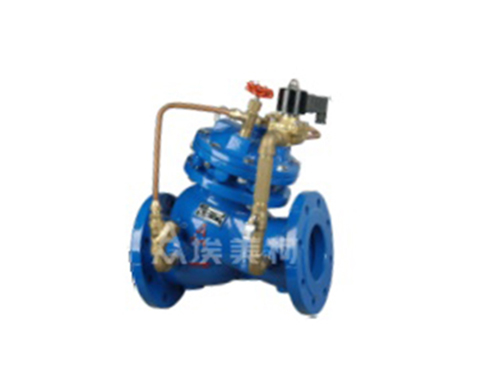The hydraulic control valve is a valve that uses the pressure of water in the pipe network to control the opening, closing and opening of the valve. It is an automatic valve that saves manpower and saves energy. Widely used in water supply pipe network systems such as hydraulic irrigation, high-rise buildings, fire protection systems, municipal water supply and drainage, electricity, etc. It has the functions of automatic water level control, decompression, pressure relief, holding pressure, adjustment, check, elimination of water hammer, switch and other functions. According to different needs, the additional pipeline and pilot valve can be changed to achieve the required function.

1. 100X remote control float valve When the pipeline feeds water from the water inlet, because the needle valve, ball valve, and float valve are normally open, the water enters the pool through the micro filter, needle valve, control room, ball valve, and float valve. No pressure is formed in the chamber, the main valve opens, and the water tower (pool) supplies water. When the water level of the water tower (pool) rises to the set height, the float floats to close the float valve, the water pressure in the control room rises, the main valve is closed, and the water supply stops. When the water level drops, the float valve reopens, the water pressure in the control room drops, the main valve opens again to continue the water supply, and maintain the set height of the liquid level.
2. 200X decompression regulator When the valve feeds water from the inlet, water flows through the needle valve into the main valve control room, and the outlet pressure acts on the pilot valve through the conduit. When the outlet pressure is higher than the pilot valve spring setting, the pilot valve closes. The control room stops draining. At this time, the pressure in the main valve control room increases and closes the main valve. The outlet pressure no longer increases. When the outlet pressure of the valve drops to the set pressure of the pilot valve spring, the pilot valve opens and the control chamber drains downstream. Because the displacement of the pilot valve system is greater than the inlet water of the needle valve, the pressure in the control chamber of the main valve drops. The inlet pressure opens the main valve. In a stable state, the inlet and outlet of the control room are the same, the opening of the main valve is unchanged, and the outlet pressure is stable. The outlet pressure can be set by adjusting the pilot valve spring.
3. 300X slow-closing check valve When the valve feeds water from the inlet end, the water enters the main valve control room through the micro filter, needle valve, and one-way valve, and then drains to the downstream through the ball valve. Because the opening of the needle valve is less than the opening of the ball valve, that is, the drainage speed of the main valve control room is greater than the water inlet speed, the pressure in the control room decreases, and the inlet pressure acting on the lower end of the main valve disc opens the main valve to supply water downstream. When the pipeline stops supplying water, if the downstream water starts to flow back, some of the return water enters the main control room through the ball valve. Due to the check valve, the return water cannot flow out of the main control room, causing the main control room to gradually increase pressure and slowly close the main valve. .
4. 400X flow control valve When the valve feeds water from the inlet, water flows through the needle valve into the main valve control room, and flows out of the main valve control room to the outlet through the pilot valve and ball valve. At this time, the main valve is in a fully open or floating state. When adjusting the flow regulating valve above the main valve, a certain opening can be set for the main valve. By adjusting the opening of the needle valve and the spring pressure of the pilot valve, the opening of the main valve can be maintained at the set opening, and the pilot valve can be automatically adjusted when the pressure changes to keep the flow rate unchanged.
Fifth, 500X holding pressure relief valve When the pressure relief valve is adjusted to the pressure relief state, water flows to the outlet through the needle valve, main valve control chamber, ball valve A, pressure relief/hold pressure pilot valve, and ball valve B. At this time, the main valve is in Open state. When the inlet pressure exceeds the safety value set by the pressure relief/hold pressure pilot valve, the pressure relief pilot valve will automatically open, and part of the water will be discharged through the ball valve C to relieve the pressure of the pipeline. When the pressure returns to a safe value, the pressure relief valve closes automatically. When used as a pressure relief valve, each ball valve is normally open. Holding pressure valve: When the pressure relief/holding pilot valve is adjusted to the holding pressure state, as long as the water pressure at the inlet of the main valve is lower than the set value of the pilot valve, the pilot valve is closed. The main control room is boosted and the main valve is closed. When the upstream water supply pressure of the main valve exceeds the set pressure of the pilot valve, the pressure-holding pilot valve can be opened. The water in the control room is discharged to the outlet through the ball valve, and the main valve of the control room decompression is opened to start water supply, that is, the upstream water pressure is maintained. When used as a pressure-holding valve, the ball valve C is normally closed or replaced with a wire plug.

